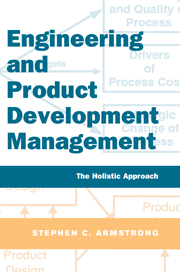Book contents
- Frontmatter
- Contents
- List of figures and tables
- Forewords
- Preface
- Acknowledgments
- Layout of book at a glance
- PART 1 UNDERSTANDING ENGINEERING PROCESS MANAGEMENT
- PART 2 APPLYING ENGINEERING PROCESSES TO PROGRAM MANAGEMENT
- 4 Roles and responsibilities
- 5 Approach to program and project management
- 6 An integrated team member's guide to performing a task
- 7 Program structuring and planning
- 8 Risk assessment
- 9 Program initiation and execution
- 10 Program reviews
- 11 Engineering change management and product data management
- PART 3 DEPLOYING ENGINEERING PROCESS MANAGEMENT
- PART 4 APPENDIXES
- Glossary
- References
- Index
5 - Approach to program and project management
Published online by Cambridge University Press: 05 April 2014
- Frontmatter
- Contents
- List of figures and tables
- Forewords
- Preface
- Acknowledgments
- Layout of book at a glance
- PART 1 UNDERSTANDING ENGINEERING PROCESS MANAGEMENT
- PART 2 APPLYING ENGINEERING PROCESSES TO PROGRAM MANAGEMENT
- 4 Roles and responsibilities
- 5 Approach to program and project management
- 6 An integrated team member's guide to performing a task
- 7 Program structuring and planning
- 8 Risk assessment
- 9 Program initiation and execution
- 10 Program reviews
- 11 Engineering change management and product data management
- PART 3 DEPLOYING ENGINEERING PROCESS MANAGEMENT
- PART 4 APPENDIXES
- Glossary
- References
- Index
Summary
An advanced engineering program requires the efforts of many professionals. Although no single contribution is ever responsible for a program's success, a project cannot hope to be successful unless it is managed well, unless all the personnel and resources involved are coordinated and directed toward a common goal.
In any organization, having people play their roles and take defined responsibilities plays a critical part in ensuring success. For example, it is very important that a functional manager take responsibility for running the organization and controlling the utilization of the resources.
This chapter focuses on the processes of program management. Reflecting on the program management workplan template, these pages discuss the major responsibilities that the program and functional directors have throughout the program. Also included is information on the interrelationship of roles.
The objective of this chapter is to outline the approach to managing a project. We stress that planning and control is an important component of any program management technique, but we will also look at specific leadership issues facing the program and functional directors, the importance of creating executive commitment to your program, and the interrelationships of key roles.
WHAT IS PROGRAM/PROJECT MANAGEMENT?
The complexity of program/project management makes it difficult to describe in a few words. Basically, however, it can be defined as planning, organizing, directing, and controlling resources to meet a specific business goal.
- Type
- Chapter
- Information
- Engineering and Product Development ManagementThe Holistic Approach, pp. 76 - 86Publisher: Cambridge University PressPrint publication year: 2001

